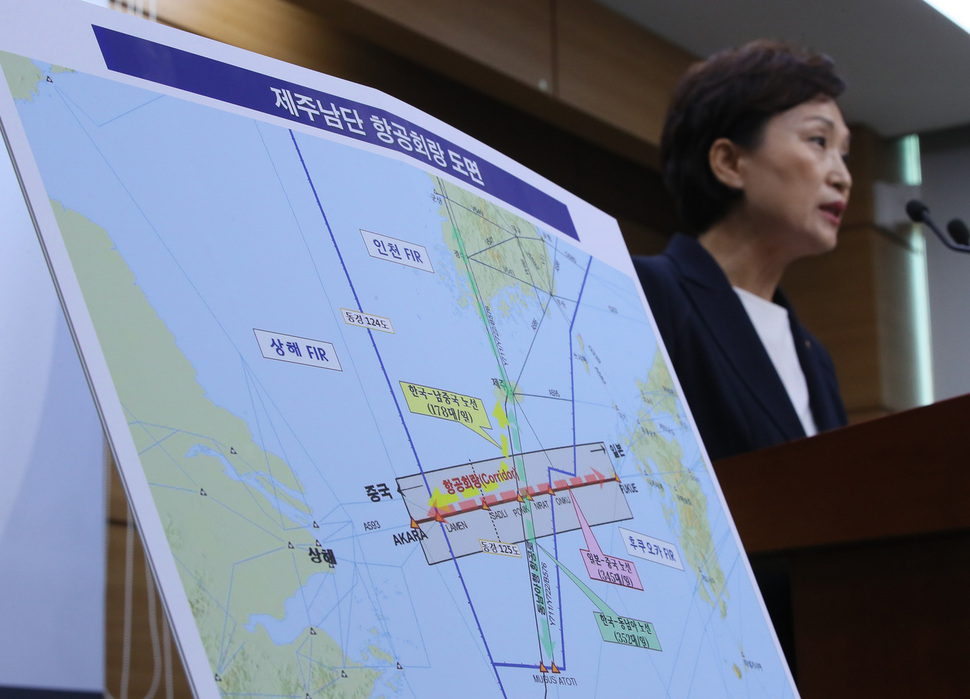 |
|
Kim Hyun-mi, minister of land, infrastructure, and transport, calls for Japan to adopt a responsible and cooperative attitude on safety issues concerning the southern Jeju air corridor on Sept. 10. (Yonhap News)
|
Seoul calls for recovery of control over corridor from Beijing and Tokyo
The South Korean government criticized Japan’s “uncooperative” attitude in discussions on safety issues concerning the southern Jeju air corridor – including the reversion of control rights exercised by China and Japan despite the area being a South Korea flight information region (FIR) – and called on Tokyo to approach discussions “responsibly” and “in good faith.” “Recently, there have been two dangerous instances in the southern Jeju air corridor where aircraft have approached each other beyond a safe distance,” explained Minister of Land, Transport and Infrastructure Kim Hyun-mi in a Sept. 10 briefing at the Sejong Government Complex. “As it is an urgent priority for the government to reduce risk, we have proposed to the International Civil Aviation Organization (ICAO) and to China and Japan that new air routes be established to ensure flight safety,” she said. An air corridor is a region where aircraft are only able to fly at certain altitudes due to difficulties with route establishment. The southern Jeju corridor is an area where Jeju-Shanghai, China-Japan, and South Korea-Southeast Asia air routes intersect. While it is included in South Korea’s FIR (airspace for which it performs control, flight information, and distress alert duties), it is also an exceptional case where China and Japan both exercise control authority. This is the result of a situation in the early 1980s when China – which at the time did not have diplomatic relations with South Korea – refused to exchange control signals with it when a direct China-Japan route was being developed through the region. The exercise of control authority by China and Japan in a South Korean FIR where three air routes intersect has resulted in a situation where even the International Air Transport Association (IATA) has pleaded for “safety precautions.” Indeed, instances of South Korean, Chinese, and US aircraft performing evasive maneuvers or changing course while passing through the corridor occurred in June and July of this year. South Korea, China, and Japan held three working group meetings between January and July 2019 to resolve the issue. The South Korean government proposed creating new air routes connecting South Korea, China, and Japan – but Japan has continued to drag its feet, and no agreement has yet been reached. “The ICAO and China support the basic idea of our proposal to create new air routes, and we have continued to hold close discussions,” Kim explained. “But Japan waited until Sept. 2, the closing date for additional negotiations, to notify us that it intended not only to keep the existing air corridor but to dualize routes there, which would exacerbate the congestion and risk,” she added. “The [South Korean] government expressed serious concerns to the Japanese government and urged them to adopt a more forward-thinking stance and immediately join dialogue,” she said. Because the southern Jeju air corridor is part of South Korea’s FIR, Seoul has asked Japanese aviation authorities to provide safety data for the Fukuoka Control Center, from which it exercises control rights for the area. The South Korean government is also considering pursuing a resolution through ICAO mediation procedures if Japan does not cooperate with establishment of a new course and reversion of control authority. By Kim Tae-gyu, staff reporter Please direct comments or questions to [english@hani.co.kr]






